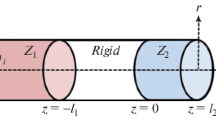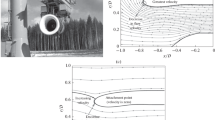Abstract
This article examines sound radiation from a hard semi-infinite duct placed symmetrically inside an acoustically lined duct. We introduce a wake on right handed region of the duct configuration to analyze sound radiation process for the trailing edge situation. The integral transforms together with Wiener–Hopf techniques render the solution of underlying problem. However expressions for field intensity involve infinite sums/products that enable solution using truncation approach. The sound radiation analysis is then observed graphically while using different choice of some pertinent parameters. It is worth mentioning that results of leading edge situation can be recovered as a limiting case.









Similar content being viewed by others
References
Rawlins, A.D.: Acoustic diffraction by an absorbing semi-infinite plane in a moving fluid. Proc. R. Soc. Edinb. Ser A 72, 337–357 (1974)
Jones, D.S.: Aerodynamic sound due to a source near a half-plane. J. Inst. Math. Appl. 9, 114–122 (1972)
Balasubramanyam, B.: Aerodynamic sound due to a point source near a half-plane. IMA J. Appl. Math. 33(1), 71–81 (1984)
Asghar, S., Ahmad, B., Ayub, M.: Point source diffraction by an absorbing half-plane. IMA J. Appl. Math. 46(3), 217–224 (1991)
Rienstra, S.W.: Sound diffraction at a trailing edge. J. Fluid Mech. 108, 443–460 (1981)
Asghar, S., Hayat, T.: Diffraction of a spherical acoustic wave near absorbing finite plane. Can. Appl. Math. Quart. 5, 1–17 (1997)
Howe, M.S.: Attenuation of sound due to vortex shedding from a splitter plate in a mean flow duct. J. Sound Vib. 105(3), 385–396 (1986)
Nawaz, R., Wahab, A., Rasheed, A.: An intermediate range solution to a diffraction problem with impedance conditions. J. Mod. Opt. 61(16), 1324–1332 (2014)
Nawaz, R., Naeem, A., Ayub, M.: Point source diffraction by a slit in a moving fluid. Waves Random Complex Media 24(4), 357–375 (2014)
Ayub, M., Nawaz, R., Naeem, A.: Diffraction of an impulsive line source with wake. Phys. Scr. 82, 045402 (2010)
Rawlins, A.D.: Acoustic diffraction by an absorbing semi-infinite plane in a moving fluid II. Proc. R. Soc. Edinb. ser A 75, 83–95 (1975)
Quinn, M.C., Howe, M.S.: Absorption of sound at a slot in a splitter plate in a mean-flow duct. J. Fluid Mech. 168, 1–30 (1986)
Hassan, M., Rawlins, A.D.: Sound radiation in a planar trifurcated lined duct. Wave Motion 29, 157–174 (1999)
Jones, D.S.: A simplifying technique in the solution of a class of diffraction problems. Quart. J. Math. 3(1), 189–196 (1952)
Lawrie, J.B., Abrahams, I.D.: A brief historical perspective of the Wiener-Hopf technique. J. Eng. Math. 59, 351–358 (2007)
Afzal, M., Nawaz, R., Ayub, M., Wahab, A.: Acoustic scattering in flexible waveguide involving step discontinuity. PLoS One 9(8), e103807 (2014)
Ayub, M., Tiwana, M.H., Mann, A.B.: Propagation of sound in a duct with mean flow. Commun. Nonlinear Sci. Numer. Simul. 14, 3578–3590 (2009)
Ayub, M., Tiwana, M.H., Mann, A.B.: Influence of the acoustic dominant mode propagation in a trifurcated lined duct with different impedances. Phy. Scr. 81, 035402 (2010)
Ayub, M., Tiwana, M.H., Mann, A.B.: Wiener-Hopf analysis of an acoustic plane wave in a trifurcated waveguide. Arch. Appl. Mech. 81, 701–713 (2011)
Jones, D.S.: The Theory of Electromagnetism. Pergamon Press, London (1964)
Noble, B.: Methods based on the Wiener-Hopf Technique, 2nd edn. Chelsea Publishing Company, New York (1988)
Brown, J.W., Churchill, R.V.: Complex Variables and Applications. McGraw-Hill Inc, New York (1996)
Demir, A., Büyükaksoy, A.: Wiener-Hopf approach for predicting the transmission loss of a circular silencer with a locally reacting lining. Int. J. Eng. Sci. 43, 398–416 (2005)
Lam, J.: Surface-wave reflection and refraction at an impedance discontinuity. J. Appl. Phys. 66(8), 3437–3444 (1989)
Kaplunov, J.D., Markushevich, D.G.: Plane vibrations and radiation of an elastic layer lying on a liquid half-space. Wave Motion 17(3), 199–211 (1993)
Cannel, P.A.: Edge scattering of aerodynamic sound by a lightly loaded elastic half-plane. Proc. R. Soc. A 347(1649), 213–238 (1975)
Cannel, P.A.: Acoustic edge scattering by a heavily loaded elastic half-plane. Proc. R. Soc. Lond. Ser. A Math. Phys. Sci. 350(1660), 71–89 (1976)
Titchmarsh, E.C.: Introduction to the Theory of Fourier Integrals. 2nd edn. Oxford University Press, Oxford (1948)
Mittra, R., Lee, S.W.: Analytical Techniques in the Theory of Guided Waves. McMillan, New York (1971)
Author information
Authors and Affiliations
Corresponding author
Appendix
Appendix
In order to separate all the functions of Wiener–Hopf functional equation in different half planes, kernel function is required to be factorized so that it is regular in different half planes and is free of singularities also. The factorization of the kernel functions \(K(\alpha )\) and \(W(\alpha )\) is of the form
where \(K_{+}(\alpha )\) and \(W_{+}(\alpha )\) denote certain functions which are regular and free of zeros in upper half plane \(\mathrm{Im}\, \alpha >-\mathrm{Im}\,k\) and \(K_{-}(\alpha )\) and \(W_{-}(\alpha )\) denote certain functions which are regular and free of zeros in lower half plane \(\mathrm{Im}\,\alpha <\mathrm{Im}\,k.\) It is noted that the functions \(K(\alpha )\) and \(W(\alpha )\) are even in \(\alpha \) and more precisely their respective derivatives are zero at \(\alpha =0.\) So these functions can be factorized by applying the infinite product expansion of an integral function with infinitely many zeros [20, 28]. From Eq. (35) we write \(K(\alpha )\) as
It is obvious that the product factorization of \(K(\alpha )\) depends upon the factorization of
and
Whilst using the procedure outlined by Mittra and Lee [29], it is found that
and
Thus
where
Here \(\beta _{n}^{,}s,\ \delta _{_{n}}^{,}s\) and \(\nu _{n}^{,}s\) are the roots of the functions \(I(\alpha ),\) \(L(\alpha )\) and \(N(\alpha ),\) respectively. That is
with
and C being the Euler’s constant given by \(C=0.57721\ldots \) and \(K_{-} (\alpha )=K_{+}(-\alpha )\). In the respective region of analyticity when \(\left| \alpha \right| \rightarrow \infty \) we have
For \(W(\alpha )\) given by Eq. (42) we may write
While opting a similar way, we get
Here \(\widetilde{\beta }_{n}^{,}s\) and \(\widetilde{\nu }_{n}^{,}\) s are the roots of the functions
and
respectively. Where C being the Euler’s constant given by \(C=0.57721\ldots \) and \(W_{-}(\alpha )=W_{+}(-\alpha )\). When \(\left| \alpha \right| \rightarrow \infty \) then in the respective region of analyticity
Rights and permissions
About this article
Cite this article
Tiwana, M.H., Nawaz, R. & Mann, A.B. Radiation of sound in a semi-infinite hard duct inserted axially into a larger infinite lined duct. Anal.Math.Phys. 7, 525–548 (2017). https://doi.org/10.1007/s13324-016-0154-4
Received:
Revised:
Accepted:
Published:
Issue Date:
DOI: https://doi.org/10.1007/s13324-016-0154-4




